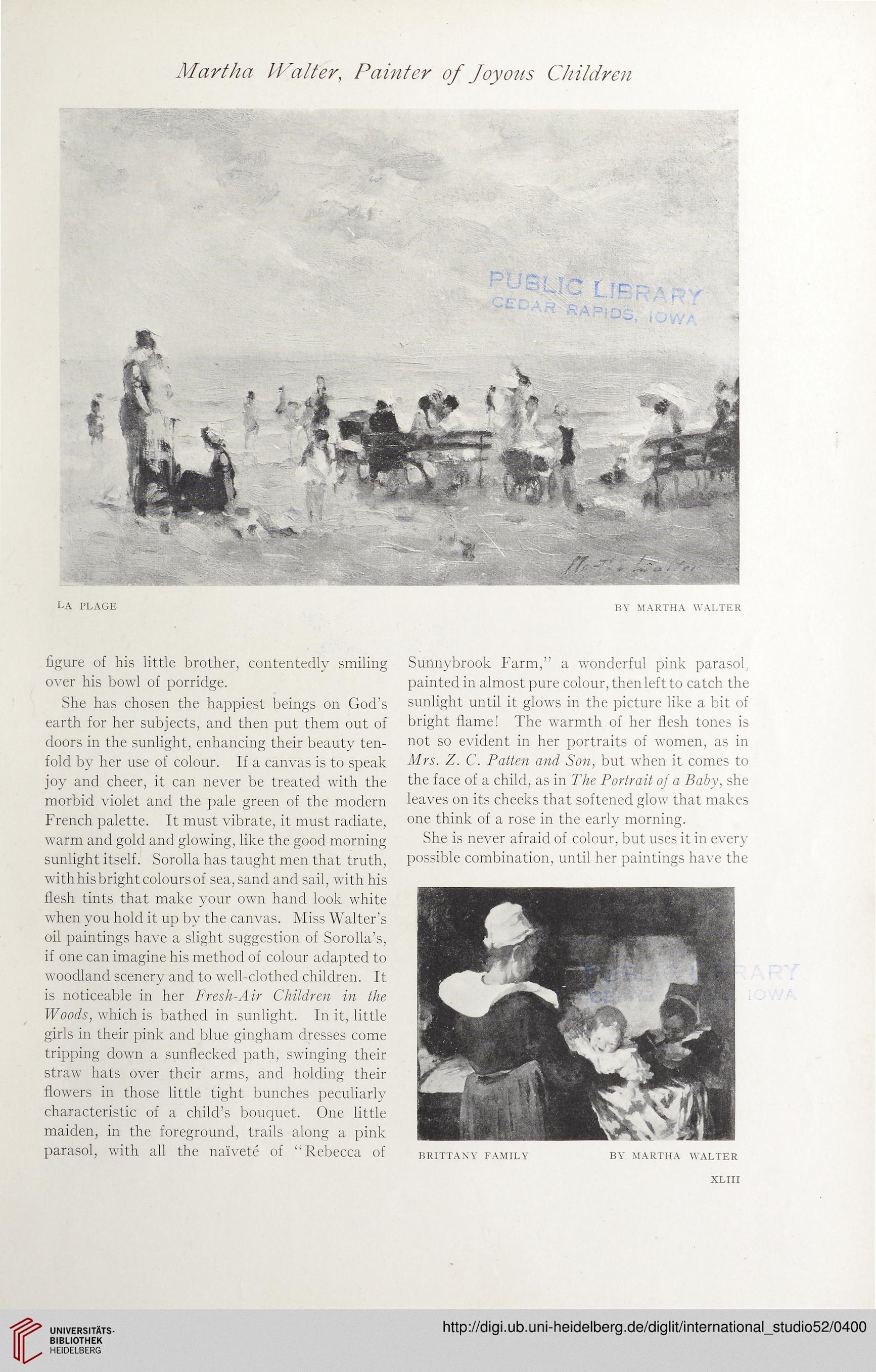Martha Walter, Painter of Joyotts Children
la PLAGE BY MARTHA WALTER
figure of his little brother, contentedly smiling
over his bowl of porridge.
She has chosen the happiest beings on God’s
earth for her subjects, and then put them out of
doors in the sunlight, enhancing their beauty ten-
fold by her use of colour. If a canvas is to speak
joy and cheer, it can never be treated with the
morbid violet and the pale green of the modern
French palette. It must vibrate, it must radiate,
warm and gold and glowing, like the good morning
sunlight itself. Sorolla has taught men that truth,
with his bright colours of sea, sand and sail, with his
flesh tints that make your own hand look white
when you hold it up by the canvas. Miss Walter’s
oil paintings have a slight suggestion of Sorolla’s,
if one can imagine his method of colour adapted to
woodland scenery and to well-clothed children. It
is noticeable in her Fresh-Air Children in the
Woods, which is bathed in sunlight. In it, little
girls in their pink and blue gingham dresses come
tripping down a sunflecked path, swinging their
straw hats over their arms, and holding their
flowers in those little tight bunches peculiarly
characteristic of a child’s bouquet. One little
maiden, in the foreground, trails along a pink
parasol, with all the naivete of “Rebecca of
Sunnybrook Farm,” a wonderful pink parasol,
painted in almost pure colour, then left to catch the
sunlight until it glows in the picture like a bit of
bright flame! The warmth of her flesh tones is
not so evident in her portraits of women, as in
Mrs. Z. C. Patten and Son, but when it comes to
the face of a child, as in The Portrait of a Baby, she
leaves on its cheeks that softened glow that makes
one think of a rose in the early morning.
She is never afraid of colour, but uses it in every
possible combination, until her paintings have the
BRITTANY FAMILY BY MARTHA WALTER
XLIII
la PLAGE BY MARTHA WALTER
figure of his little brother, contentedly smiling
over his bowl of porridge.
She has chosen the happiest beings on God’s
earth for her subjects, and then put them out of
doors in the sunlight, enhancing their beauty ten-
fold by her use of colour. If a canvas is to speak
joy and cheer, it can never be treated with the
morbid violet and the pale green of the modern
French palette. It must vibrate, it must radiate,
warm and gold and glowing, like the good morning
sunlight itself. Sorolla has taught men that truth,
with his bright colours of sea, sand and sail, with his
flesh tints that make your own hand look white
when you hold it up by the canvas. Miss Walter’s
oil paintings have a slight suggestion of Sorolla’s,
if one can imagine his method of colour adapted to
woodland scenery and to well-clothed children. It
is noticeable in her Fresh-Air Children in the
Woods, which is bathed in sunlight. In it, little
girls in their pink and blue gingham dresses come
tripping down a sunflecked path, swinging their
straw hats over their arms, and holding their
flowers in those little tight bunches peculiarly
characteristic of a child’s bouquet. One little
maiden, in the foreground, trails along a pink
parasol, with all the naivete of “Rebecca of
Sunnybrook Farm,” a wonderful pink parasol,
painted in almost pure colour, then left to catch the
sunlight until it glows in the picture like a bit of
bright flame! The warmth of her flesh tones is
not so evident in her portraits of women, as in
Mrs. Z. C. Patten and Son, but when it comes to
the face of a child, as in The Portrait of a Baby, she
leaves on its cheeks that softened glow that makes
one think of a rose in the early morning.
She is never afraid of colour, but uses it in every
possible combination, until her paintings have the
BRITTANY FAMILY BY MARTHA WALTER
XLIII




